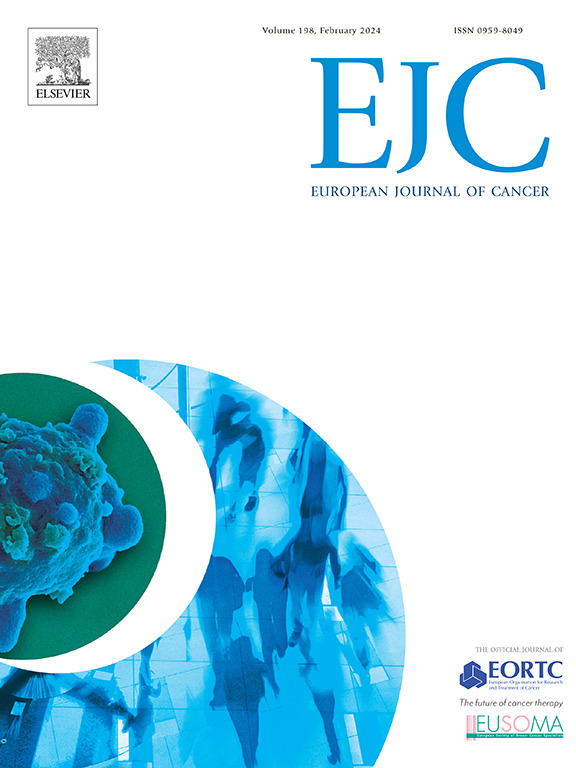SPECTA-AYA研究中青少年和年轻人高级别胶质瘤的分子分析:特征不佳的肿瘤,经常发生种系改变
IF 7.6
1区 医学
Q1 ONCOLOGY
引用次数: 0
摘要
背景:青少年和青壮年(AYA)高级别胶质瘤(HGG)是AYA恶性肿瘤中生存率最差的,但在大规模分子数据集中却很少有代表性。方法前瞻性招募50名12-29岁新诊断或复发的HGG和其他高危中枢神经系统(CNS)肿瘤患者,进行EORTC SPECTA平台研究,进行全外显子组测序、RNA测序和甲基化分析,并进行中枢病理检查。报告了可操作的突变,并随访了患者的治疗和结果。结果在46例局部诊断的HGGs和4例复发性中枢神经系统肿瘤中,分子和病理检查导致组织学分级重新分类(n = 10),诊断细化(n = 9)和修订诊断(n = 12)的比例很大。致病性结构改变总体上存在14% %,并且主要局限于idh野生型胶质母细胞瘤和儿科型弥漫性hgg病例。91% %的hgg具有影响RAS/RAF/MAPK(60% %)、PI3K/AKT/mTOR(27% %)和细胞周期基因(11% %)的潜在可操作改变。高肿瘤突变负担(>;10个体细胞非同义突变(每Mb基因组靶向)在诊断时存在12% %,复发时存在18% %,均为组织学级别4的肿瘤。根据分子谱改变了10例患者的治疗方案,其中5例患者在最后随访时仍在治疗。结论:aya HGGs由多种实体组成;准确的、分子定义的诊断对于指导初级治疗、确定遗传易感性风险和指导分子定向治疗至关重要。目前的服务不能常规地解决这一高风险、预后差的罕见癌症患者群体的诊断、个性化分子分析或治疗机会的调查。本文章由计算机程序翻译,如有差异,请以英文原文为准。
Molecular analysis of adolescent and young adult high grade gliomas in the SPECTA-AYA study: Poorly characterised tumours with frequent germline alterations
Background
Adolescent and young adult (AYA) high grade gliomas (HGG) have the worst survival of AYA malignancies yet are poorly represented in large-scale molecular datasets.
Methods
50 AYAs aged 12–29 with newly diagnosed or recurrent HGG and other high risk central nervous system (CNS) tumours were prospectively recruited to the EORTC SPECTA platform study and underwent whole exome sequencing, RNA sequencing and methylation profiling, with central pathological review. Actionable mutations were reported and patients followed up for therapies and outcome.
Results
From 46 locally diagnosed HGGs and 4 other recurrent CNS tumours, molecular and pathology review resulted in histological grade re-classification (n = 10), diagnostic refinement (n = 9) and revised diagnoses (n = 12) in a substantial proportion. Pathogenic constitutional alterations were present in 14 % overall and were largely limited to cases with IDH-wildtype glioblastoma and paediatric-type diffuse HGGs. 91 % of HGGs had potentially actionable alterations affecting RAS/RAF/MAPK (60 %), PI3K/AKT/mTOR (27 %) and cell cycle genes (11 %). High tumour mutational burden (> 10 somatic non-synonymous mutations per Mb of genome targeted) was present in 12 % at diagnosis and 18 % at recurrence, all in histological grade 4 tumours. Ten patients’ treatment was modified on the basis of molecular profile, of whom 5 remained on treatment at last follow-up.
Conclusion
AYA HGGs comprise a diverse group of entities; accurate, molecularly-defined diagnosis is critical to direct primary treatment, determine risk of genetic predisposition and guide molecularly-directed therapy. Current services fail to routinely address diagnosis, personalised molecular profiling or investigation of therapeutic opportunities for this high risk, poor prognosis group of rare cancer patients.
求助全文
通过发布文献求助,成功后即可免费获取论文全文。
去求助
来源期刊

European Journal of Cancer
医学-肿瘤学
CiteScore
11.50
自引率
4.80%
发文量
953
审稿时长
23 days
期刊介绍:
The European Journal of Cancer (EJC) serves as a comprehensive platform integrating preclinical, digital, translational, and clinical research across the spectrum of cancer. From epidemiology, carcinogenesis, and biology to groundbreaking innovations in cancer treatment and patient care, the journal covers a wide array of topics. We publish original research, reviews, previews, editorial comments, and correspondence, fostering dialogue and advancement in the fight against cancer. Join us in our mission to drive progress and improve outcomes in cancer research and patient care.
 求助内容:
求助内容: 应助结果提醒方式:
应助结果提醒方式:


